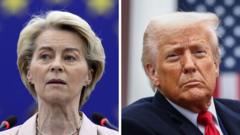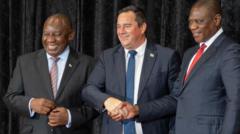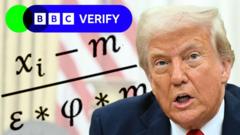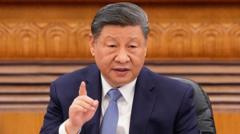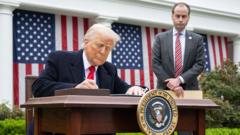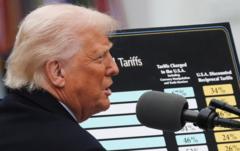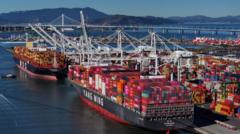President Donald Trump has introduced a new series of sweeping tariffs aimed at reshaping the United States' trading relationships, imposing a 10 percent tariff on nearly all U.S. trade partners, with exceptions for Canada and Mexico. The tariffs were announced during a ceremony at the White House, where Trump referred to the move as “our declaration of economic independence,” celebrating it as a moment of liberation for the American economy.
Trump Enacts Major Tariffs on Global Trade Partners

Trump Enacts Major Tariffs on Global Trade Partners
President Trump's sweeping tariff announcement aims to reshape international economic relations, drawing mixed reactions.
The newly instituted tariffs vary significantly, with China facing an extraordinary 34 percent tariff, while the European Union (E.U.) will incur a 20 percent tariff. Japan's goods will see a 24 percent increase, and India will face a 26 percent levy. Trump's administration is positioning these tariffs as a necessary response to what they depict as years of economic exploitation of the United States by other nations.
Some experts suggest that while the tariffs may repatriate some manufacturing operations back to American soil, they also forecast increased costs for consumers and potential for an escalating trade war. “Many analysts predicted the president would unveil high tariffs today, but the actual figures are remarkably high,” noted Ana Swanson, an international trade journalist. She added that the economic implications could be profound, inciting reactions from countries around the globe.
The impacts of these tariffs may also lead to internal conflicts among Trump's advisers, with differing opinions on whether the primary goal is to generate revenue or create lower barriers for trade. Observers continue to monitor the situation closely, aware of the domino effects these tariffs could pose to the global economy. As global players respond, uncertainty looms over the future of international trade relations and economic stability.
Some experts suggest that while the tariffs may repatriate some manufacturing operations back to American soil, they also forecast increased costs for consumers and potential for an escalating trade war. “Many analysts predicted the president would unveil high tariffs today, but the actual figures are remarkably high,” noted Ana Swanson, an international trade journalist. She added that the economic implications could be profound, inciting reactions from countries around the globe.
The impacts of these tariffs may also lead to internal conflicts among Trump's advisers, with differing opinions on whether the primary goal is to generate revenue or create lower barriers for trade. Observers continue to monitor the situation closely, aware of the domino effects these tariffs could pose to the global economy. As global players respond, uncertainty looms over the future of international trade relations and economic stability.

